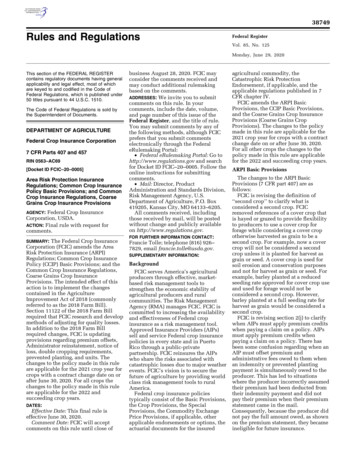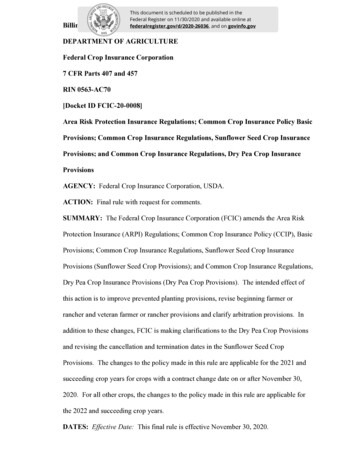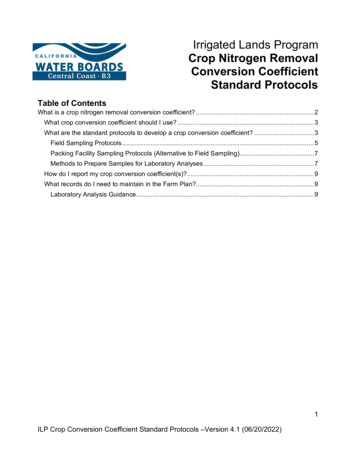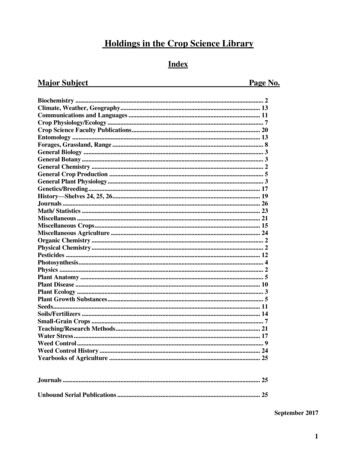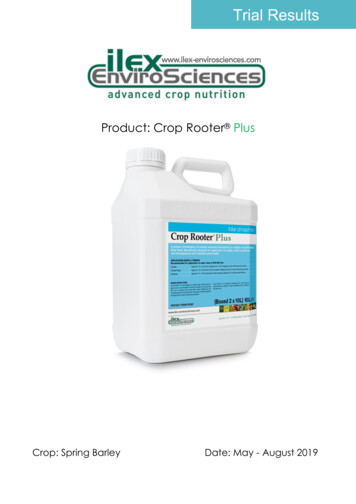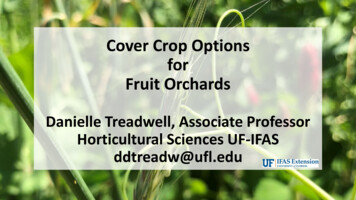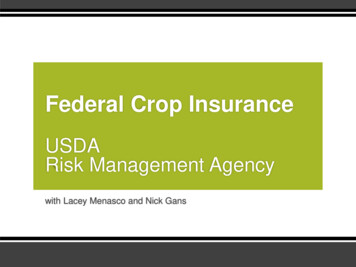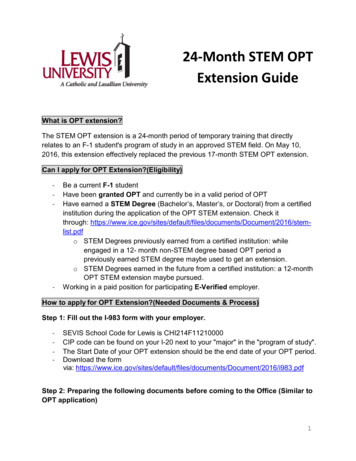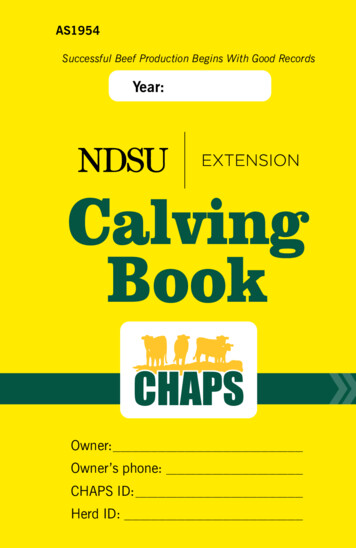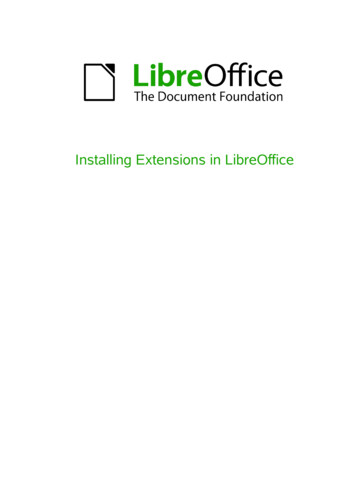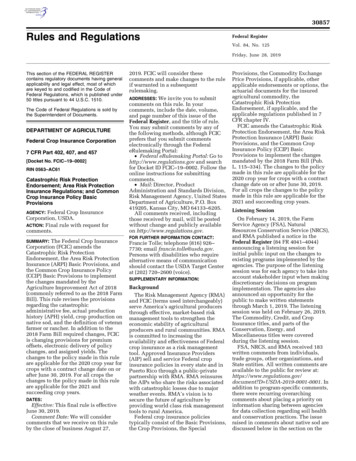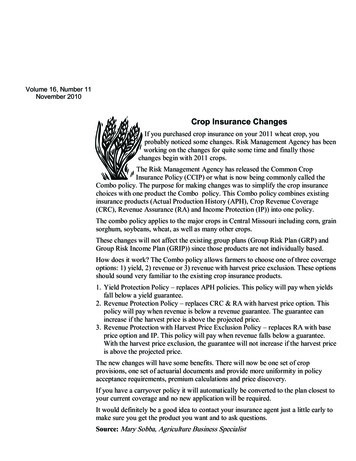
Transcription
Volume 16, Number 11November 2010Crop Insurance ChangesIf you purchased crop insurance on your 2011 wheat crop, youprobably noticed some changes. Risk Management Agency has beenworking on the changes for quite some time and finally thosechanges begin with 2011 crops.The Risk Management Agency has released the Common CropInsurance Policy (CCIP) or what is now being commonly called theCombo policy. The purpose for making changes was to simplify the crop insurancechoices with one product the Combo policy. This Combo policy combines existinginsurance products (Actual Production History (APH), Crop Revenue Coverage(CRC), Revenue Assurance (RA) and Income Protection (IP)) into one policy.The combo policy applies to the major crops in Central Missouri including corn, grainsorghum, soybeans, wheat, as well as many other crops.These changes will not affect the existing group plans (Group Risk Plan (GRP) andGroup Risk Income Plan (GRIP)) since those products are not individually based.How does it work? The Combo policy allows farmers to choose one of three coverageoptions: 1) yield, 2) revenue or 3) revenue with harvest price exclusion. These optionsshould sound very familiar to the existing crop insurance products.1. Yield Protection Policy – replaces APH policies. This policy will pay when yieldsfall below a yield guarantee.2. Revenue Protection Policy – replaces CRC & RA with harvest price option. Thispolicy will pay when revenue is below a revenue guarantee. The guarantee canincrease if the harvest price is above the projected price.3. Revenue Protection with Harvest Price Exclusion Policy – replaces RA with baseprice option and IP. This policy will pay when revenue falls below a guarantee.With the harvest price exclusion, the guarantee will not increase if the harvest priceis above the projected price.The new changes will have some benefits. There will now be one set of cropprovisions, one set of actuarial documents and provide more uniformity in policyacceptance requirements, premium calculations and price discovery.If you have a carryover policy it will automatically be converted to the plan closest toyour current coverage and no new application will be required.It would definitely be a good idea to contact your insurance agent just a little early tomake sure you get the product you want and to ask questions.Source: Mary Sobba, Agriculture Business Specialist
Fall FertilizationOver the last few years, high fertilizer prices combinedwith wet falls and late harvest have resulted in many fieldsnot receiving all of the phosphorous (P) and potassium (K)needed to maintain optimum test levels. However, this falllooks promising for P and K applications with the earlyharvest and drying soil conditions. With current grainprices, the return on fertility investment may be greaterthan when grain prices were lower.How should the P and K fertilizer be placed?Some placement possibilities are; incorporation in the soilwith tillage, left on the surface, banded on the surface, orbanded deep (4-8 inches) below thesurface. However, University researchfrom the Midwest indicates that howyou apply P and K does not matter.What is important is that you apply it orthat you confirm that test levels areadequate for crop production. Deepbanding is sometimes suggestedbecause it makes the nutrient moreavailable but, the only time researchershave seen an advantage to deepplacement is when soil test levels arelow.What about annual versus biennial applications?University research indicates that as long as the neededfertilizer to make sure soil tests levels are adequate tosupply what the crops need, no yield benefit hinges onwhether the application is done every year or every otheryear. Biennial application will result in saving time andmaking one less pass over the field. Research has shownthat with biennial applications it is better to apply fertilizerbefore the corn crop and to have soybean as a residualfeeder. If your soil test does not build up, annualapplications may result in better soil test levels.Is it better to apply P and K in fall or spring?Many studies indicate that as far as providing nutrients tothe crop; neither spring or fall applications is better atincreasing nutrient availability. Fall application providesthe advantage of more time and equipment available thanthe spring planting season. Soil compaction is usually lessof concern in the fall and tillage operations are morefeasible in the fall. One potential drawback for fallapplication is the fact that the nitrogen (N) accompanyingP in MAP and DAP is more susceptible to loss even ifapplied in the fall. The benefits of a fall applicationtypically can outweigh the potential for any small N losses.It should be noted that if you are following corn with corn;corn can remove more P and less K than soybeans.Therefore, your fertilization plans should be adjustedaccordingly to your cropping situation.Source: Wayne Crook, Agronomy Specialist2Fall ChoresFall is a time for beef producers to assess the past growingseason and prepare for the upcoming winter months.Evaluating the forage base and livestock performance canhelp identify changes that need to be made in upcominggrowing seasons.1. Pasture and hay fields should be monitored for weedpressure and the presence of toxic plants. Identify and markproblem areas so they can be treated in a timely mannernext year.2. Assess grass stands and identify areas for possiblerenovation to thicken the stand.3. Soil test and identify nutrientdeficiencies so fertilizer and lime dollarscan be spent more efficiently to correctexisting problems.4. Inventory and quality test haysupplies. Based on the hay test resultsI’ve seen so far this year, hay qualitywill be relatively poor. Energy contentin particular has been extremely poor.Identify sources of needed nutrients anddevelop cost-effective feeding programs.5. Body condition scoring of the cow herd is essential,especially this year. Be sure to wean calves before cowbody condition is depleted. It will be expensive to add bodycondition this year, based on the energy content of thisyear’s hay crop. The cheapest way to add weight andcondition to cows before winter is to not let them lose it inthe first place. Remember, adding weight is a function ofincreasing the energy intake of the animals. Low levels ofprotein supplementation will not provide enough energy toimprove body condition. High energy supplements such asgrains or grain by-products will need to be fed, especially ifthe cows are thin and need to add condition.6. Evaluate the performance of the calf crop. How did itcompare to past years? Do changes in the breedingprogram, such as new bloodlines or crossbreeding, need tohappen? Are cow and heifer pregnancy rates where theyshould be? If not, why not? Do you know which cows areperforming better than others? Maybe it’s time to look atproduction record software to help manage the cow herdand provide information to make better culling decisions.7. Get your hands on a 2011 calendar; make notes on theappropriate months to identify management priorities forproblem areas. These reminders can be especially helpfulwith items such as weed control programs. Listing thesemanagement practices will help ensure they are done on atimely basis.Source: Gene Schmitz, Livestock Specialist
Taxation TidbitsCongress has passed another “band-aid” for the strugglingeconomy. On September 23, the House passed the Senateversion of HR 5297 and the President signed the legislationon September 27. This legislation is formally known as theSmall Business Jobs and Credit Act of 2010.Let’s delve into some of this legislation’s major taxprovisions. Business capital asset expensing has become apopular tax incentive for encouraging business assetexpenditures. HR 5297 increases the maximum Section 179expensing amount up to 500,000 per year for 2010 and2011. Additionally, the maximum expenditure before thephase-out of the deduction has been increased from 800,000 to 2,000,000. The phase-out is dollar for dollarfor Section 179 asset purchases over 2,000,000.A new feature for Section 179 is that some real propertyimprovement expenditures will also qualify for expensing.Previously, real property has been excluded from Section179 expensing. HR 5297 provides for the expensing of upto 250,000 for expenditures of qualified restaurantproperty, qualified retail improvement property, andqualified leasehold improvement property.Another tax provision, first-year 50% bonus depreciation,has been reinstituted for 2010 and to a limited extent for2011. Both Section 179 and the bonus depreciationprovisions are retroactive to January 1, 2010. For the mostpart bonus depreciation will expire “again” at the end of2010. However, HR 5297 extends the benefit of bonusdepreciation through 2011 forqualifying assets with arecovery period of 10 years orlonger and for businesstangible personal property usedto transport people or property.Thus for example, bonusdepreciation will be extendedthrough 2011 for farm capitalexpenditures for general farmbuildings and over-the-roadtractors and trailers.HR 5297 also levels the playing field regarding the taxtreatment of health insurance premium payments – at leastfor 2010. Prior to this legislation, the self-employed coulddeduct the cost of their family’s health insurance forcalculating income tax, but not for calculating theirself-employment tax. HR 5297 makes the cost of healthinsurance deductible in calculating income tax andself-employment tax. This provision appears to be availablefor only 2010. Certainly many business groups will belobbying to have the provision extended.Late in the tax year legislation and short-duration provisionsseems to occurring with greater frequency. It is unfortunateCongress waits until the tax year is 9 months old to passshort-term tax provisions designed for stimulating theeconomy. However, if you have already made somequalifying expenditures or are planning some in the nearfuture – this legislation should save you some tax dollarsand be good for your bottom line.Source: Parman R. Green, Ag Business Mgmt. SpecialistTips for Mowing Leaves1. A sharp mower blade is more effective, and it may bedull after a long season of mowing.2. Do not mow shorter thenyou normally would, andhaving the grass a littlelonger will allow the leafpieces to sift down so theyare less visible. A height of3 to 4 inches is oftensuggested.3. Mow before the layer ofleaves piles up too high.More than 3-4 inches ofleaves is probably too much. Also, don’t let a denselayer of leaves (especially wet and matted) lie on turftoo long; more then 4 days is not advised. Given anextended rainy spell, raking may be needed.4. Don’t mow too fast; the leaves won’t chop up as well.A normal speed, or slightly slower will work well.5. Dry leaves chop up better, so this can be DUSTY.Wear a dusk mask over your nose and mouth as wellas safety goggles. Mowing when the leaves are dampfrom dew may suppress the dust, but mowing wetleaves doesn’t work.6. Mulching mowers are preferred, so if using a rotarymower be safe and inspect and remove any sticks orlimbs, they may be somewhat hidden.Benefits from mowing leaves: Less time, returningnutrients and organic matter to the turf, and theenvironmental benefits of reduced smoke, less landfillwaste, less bag usage, and less transportation costs are just afew.Source: James Quinn, Horticulture Specialist; BradFresenburg, turfgrass Specialist; Dr. Chris Starbuck, StateHorticulture Specialist
Beef AI Portable Barns for RentCentral Missouri cow/calf producers interested in using artificial insemination (AI) and estrus synchronization to increasegenetic quality and consistency in their herds have access to tools and facilities to help. Two artificial insemination barns areavailable to cow/calf producers in the central Missouri region. The double stall barn rent is 50.00 per day of use and thesingle stall barn is 25 per day of use; which will cover maintenance and upkeep on the barns.The AI barn keeps cattle quieter during the insemination process, making the insemination process safer and quicker forthe inseminator as well. The dark environment the barn provides makes cattleeasier to handle and inseminate along with providing an indoor environment forthe inseminator to work.To use the Central Missouri AI barns:Double Barn: Contact Gene Schmitz, livestock specialist at 660-438-5012. The charge to use the barn is 50 per day of use. The barn is located at the Benton County Extension Center in Warsaw.Single Barn: Contact the Callaway County Extension Office at 573-642-0755 The charge to use the barn is 25 per day of use. The barn is located in HermannPicture of double stall AI Barn
In This Issue: Crop Insurance Changes Fall Fertilization Fall Chores Taxation Tidbit Tips for Mowing Leaves Beef AI Portable Barns forRent
Crop Insurance Changes If you purchased crop insurance on your 2011 wheat crop, you probably noticed some changes. Risk Management Agency has been . Insurance Policy (CCIP) or what is now being commonly called the Combo policy. The purpose for making changes was to simplify the crop insurance choices with one product the Combo policy. This .
